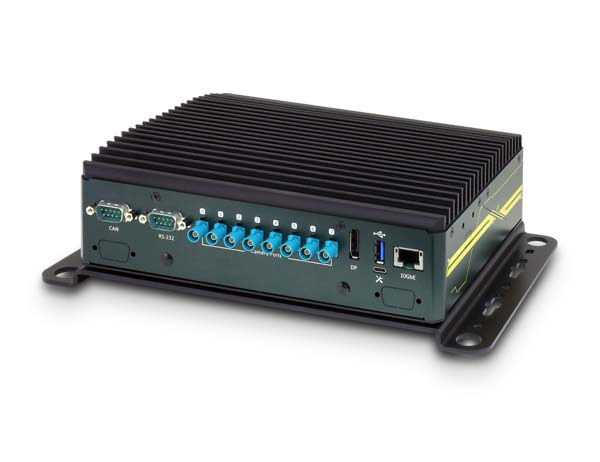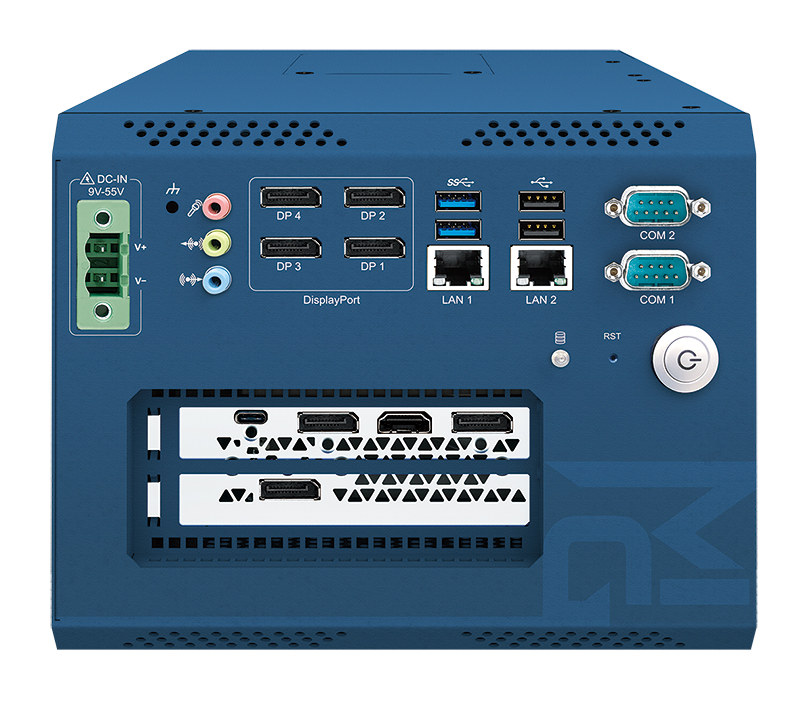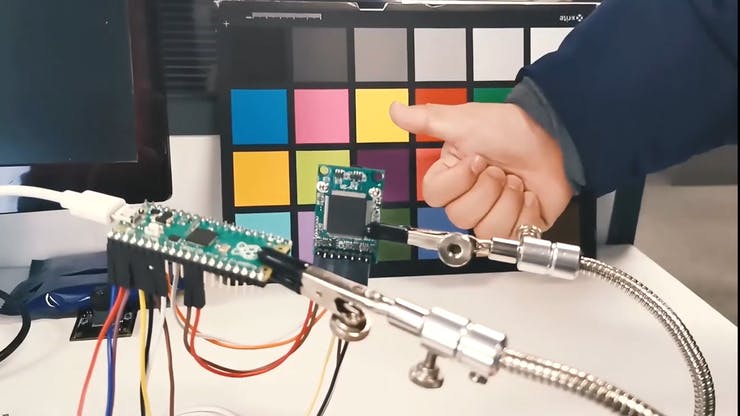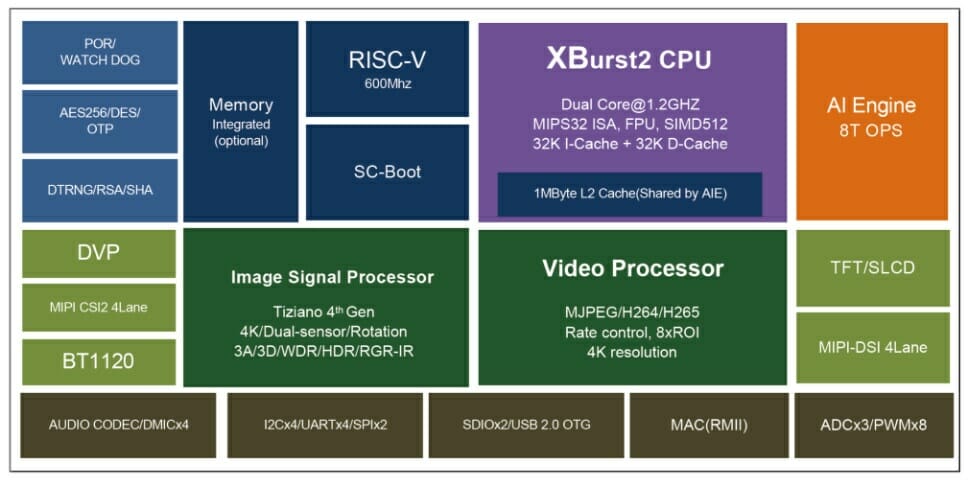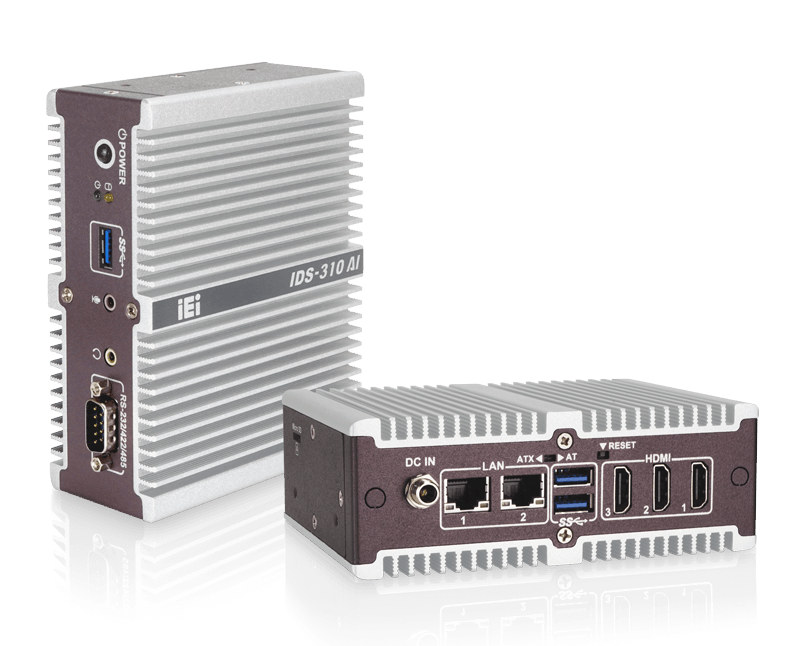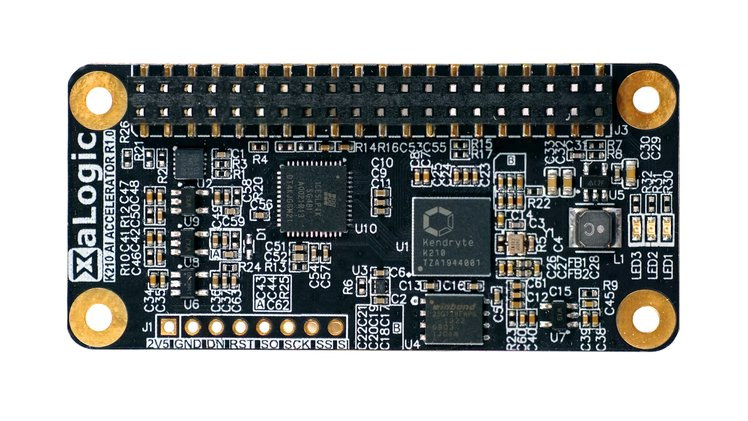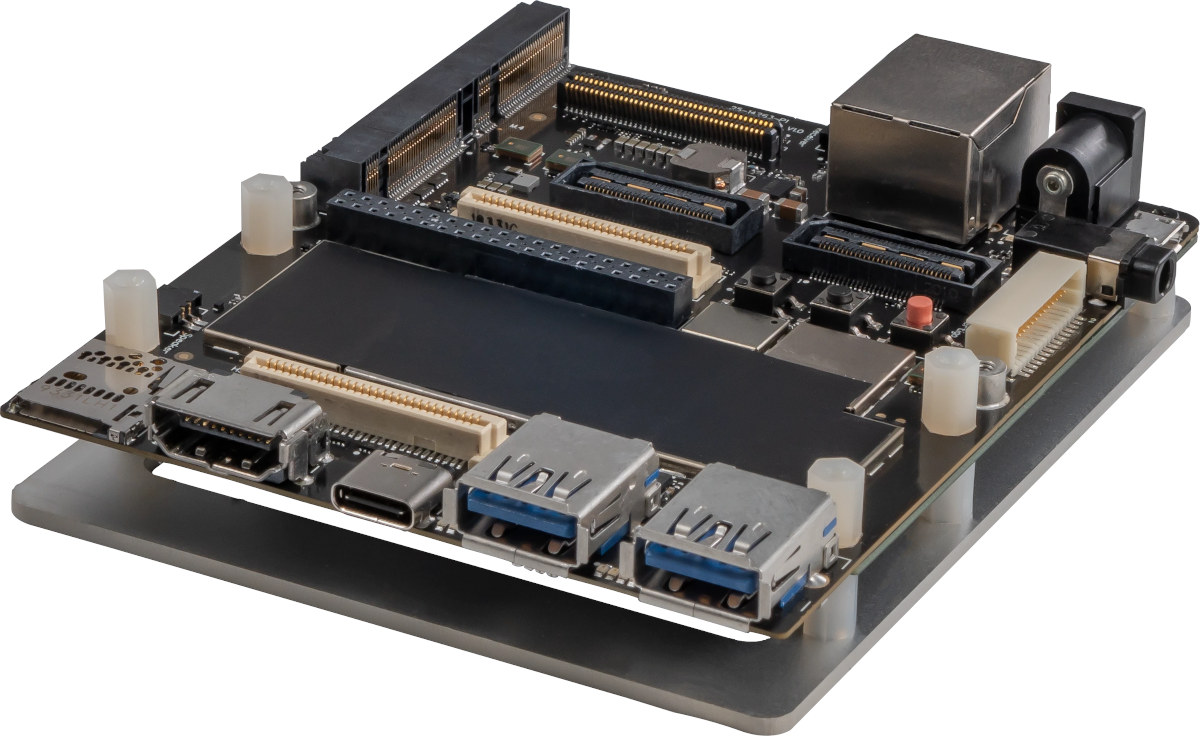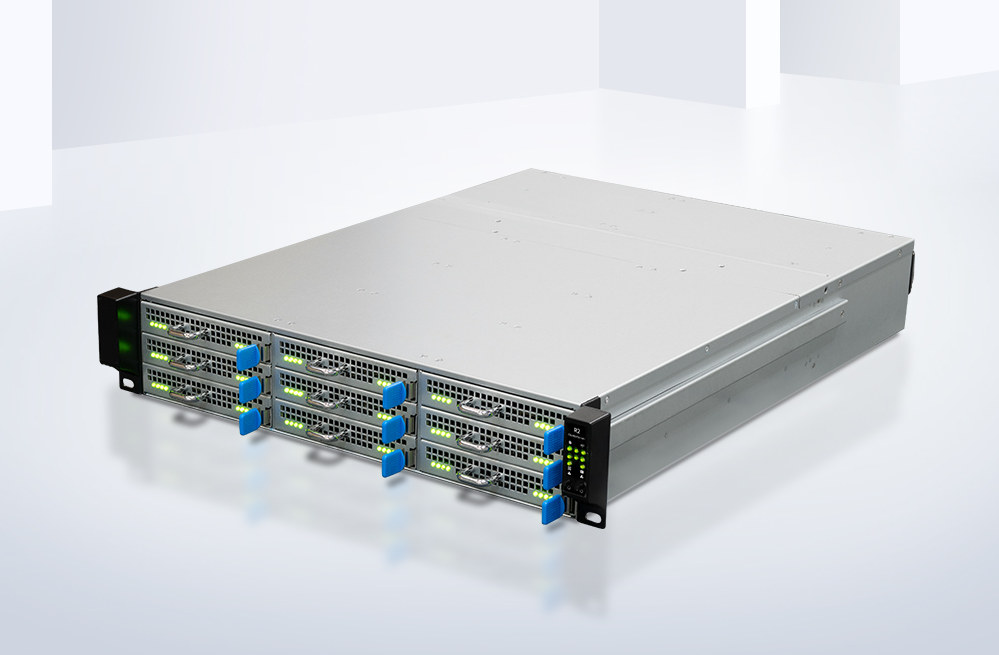Neousys Technology, a Taiwan-based provider of rugged embedded systems, has introduced the NRU-110V Edge AI inference platform powered by an NVIDIA Jetson AGX Xavier SoM. It comes with eight FAKRA Z connectors to support up to eight GMSL automotive cameras, as well as one 10GbE (10 Gigabit Ethernet) port for real-time video data transfer. The system specifically supports GMSL cameras with 3-exposure HDR, LED flicker mitigation, good light-sensitivity, and IP67 waterproof characteristics, and also comes with a synchronize mechanism to simultaneously capture high-quality images from 8 GMSL cameras while accepting GPS PPS signal to align image data with other sensors. That makes it suitable for various applications ranging from autonomous driving, mobile robots, precision agriculture, intelligent V2X, to teleoperation. Neousys NRU-110V specifications: System-on-Module – NVIDIA Jetson AGX Xavier SoM with SoC NVIDIA 512-core Volta GPU 8-core Arm Carmel CPU 2x NVDLA Engines 7-Way VLIW Vision Processor Memory – 32GB LPDDR4x […]
Ryzen Embedded V1807B AI Edge PC supports dual-slot graphics cards
Many AI edge computers come with dedicated AI accelerators from Intel, Google, Gyrfalcon, and others. But as we’ve seen with Cincoze GM-1000 embedded mini PC, some include support for more traditional GPUs, in this case, an NVIDIA Quadro Embedded P2000 MXM module. Ryzen Embedded V1807B powered Vecow MIG-1000 AI edge PC is another such solution with up to 64GB DDR4, four DisplayPort outputs, and a PCIe x16 slot for dual-slot graphics cards from Nvidia or AMD for AI processing performance and/or extra video outputs. Vecow MIG-1000 specifications: SoC – AMD Ryzen Embedded V1807B quad-core processor with Radeon Vega 11 graphics; 35-54W TDP System Memory – 2x DDR4 3200MHz SO-DIMM, up to 64GB Storage – 1x SATA-III port, 1x M.2 Key M socket (2280, PCIe x4) for NVMe SSDs Video Output – 4x DisplayPort up to 4096 x 2160 @ 60Hz Audio Realtek ALC662, 5.1 Channel HD Audio codec 1x Mic-in, […]
Person Detection on Raspberry Pi Pico with ArduCAM and TensorFlow Lite
ArduCAM is popular for camera-based applications with various boards ranging from Arduino to Raspberry Pi. We also saw the company’s tiny coin-sized Raspberry Pi compatible module 5 years ago. Now, it also supports the newly launched Raspberry Pi Pico for real-time video applications. Raspberry Pi Pico is compatible with the ArduCAM Mini 2MP Plus camera featuring an OV2640 2MP CMOS image sensor that supports automatic image control functions including Automatic Exposure Control (AEC) and Automatic Gain Control(AGC). The camera also comes with an onboard JPEG encoder for image compression. The company has provided a Github repository with two demo applications: a video streaming application and an example for basic person detection with the probability percentage of detection. There is also an option of directly using the UF2 files for flashing with Raspberry Pi Pico, if you don’t want to build the demo from the source code yourself. The application runs […]
Ingenic T40 4K Video & AI Vision Processor mixes MIPS & RISC-V cores with AI accelerator
Ingenic T31 MIPS & RISC-V AI video processor was introduced last year with the MIPS core including SIMD128 Vector instructions for deep learning. The Chinese company has now introduced the new Ingenic T40 processor still with MIPS and RISC-V cores, but also a dedicated 8 TOPS AI engine/CNN accelerator. The new processor is especially suited to smart AI vision application thanks to support for 4K cameras, and 4K MJPEG/H.264/H.265 hardware video encoding, complemented by the 8 TOPS AI engine for computer vision workloads such as people detection, face recognition, object detection, and so on. Ingenic T40 key features and specifications: CPU – Dual-core MIPS XBurst2 @ 1.2 GHz with 256KB L2 Cache, SIMD512 instruction set MCU – 600MHz RISC-V coprocessor AI Engine – 8 TOPS neural network accelerator with 1MB memory pool, support for int16/int8/int4/int2 convolution width Memory – DDR2/DDR3/DDR3L up to 2GB Storage – SPI NOR flash, SPI NAND flash, […]
AI digital signage system combines Apollo Lake SoC with Myriad X AI accelerators
Digital signage players were traditionally used to display photos and text, play some videos, or PowerPoint presentations. But like with so many other devices, they can also be enhanced with artificial intelligence with, for instance, facial recognition enabling more personalized information, weather detection showing targeted advertisement (umbrella when it rains, sunglasses on sunny days…), and other data collection. IEI IDS-310AI fanless AI digital signage system can enable these types of features thanks to an Intel Celeron J3455 Apollo Lake processor combined with two Myriad X VPU’s, and the ability to drive three displays through HDMI. IDS-310AI digital signage mini PC specifications: SoC – Intel Celeron J3455 quad-core processor @ 1.5GHz / 2.3GHz (Turbo); 10W TDP System Memory – 1 x 204-pin DDR3L SO-DIMM, 8 GB pre-installed Storage – 128GB SATADOM, MicroSD card slot Video Output – 3x HDMI 1.4b ports up to 3840×2160 @ 30Hz each Audio – 1x Mic […]
K210 AI Accelerator Raspberry Pi pHAT targets secure AIoT projects (Crowdfunding)
Kendryte K210 is a dual-core RISC-V AI processor that was launched in 2018 and found in several smart audio and computer vision solutions. We previously wrote a Getting Started Guide for Grove AI HAT for Raspberry Pi using Arduino and MicroPython, and XaLogic XAPIZ3500 offered an even more compact K210 solution as a Raspberry pi pHAT with Raspberry Pi Zero form factor. The company is now back with another revision of the board called “XaLogic K210 AI accelerator” designed to work with Raspberry Pi Zero and larger boards with the 40-pin connector. K210 AI Accelerator board specifications: SoC – Kendryte K210 dual-core 64-bit RISC-V processor @ 400 MHz with 8MB on-chip RAM, various low-power AI accelerators delivering up to 0.5 TOPS, Host Interface – 40-pin Raspberry Pi header using: SPI @ 40 MHz via Lattice iCE40 FPGA I2C, UART, JTAG, GPIOs signals Security Infineon Trust-M cloud security chip 128-bit AES […]
Snapdragon 888 Mobile Hardware Development Kit ships with 12GB RAM, 256GB UFS storage
Snapdragon 888 is the latest premium mobile SoC from Qualcomm with the octa-core processor combining one Cortex-X1 core, three Cortex-A78 cores, and four low-power Cortex-A55 cores, with Adreno 660 GPU and Snapdragon X60 5G modem. The processor will likely most be found in smartphones, but Qualcomm partnered with Lantronix to launch the Snapdragon 888 Mobile Hardware Development Kit designed for Android app developers, hardware vendors, and original equipment manufacturers (OEMs). Snapdragon 888 development board specifications: SoC – Qualcomm Snapdragon 888 (SM8350) octa-core Qualcomm Kryo 680 CPU with 1x Cortex-X1 core @ 2.84 GHz, 3x Cortex-A78 cores @ 2.42 GHz, and 4x Cortex-A55 cores @ 1.80 GHz, Adreno 660 GPU with support for OpenCL 2.0 FP, OpenGL ES 3.2, Vulkan 1.1, DX12, and up to 8K 360 VR video playback, Hexagon 780 DSP System Memory – 12GB LPDDR5 PoP memory Storage – 256GB UFS 3.0 flash, 1x MicroSD/UFS card Display HDMI […]
Cluster Server R2 2U rack cluster server ships with up to 72 Rockchip RK3399/RK3328 SoMs
Rockchip RK3399 and RK3328 are typically used in Chromebooks, single board computers, TV boxes, and all sort of AIoT devices, but if you ever wanted to create a cluster based on those processor, Firefly Cluster Server R2 leverages the company’s RK3399, RK3328, or even RK1808 NPU SoM to bring 72 modules to a 2U rack cluster server enclosure, for a total of up to 432 Arm Cortex-A72/A53 cores, 288 GB RAM, and two 3.5-inch hard drives. Firefly Cluster Server R2 specifications: Supported Modules Core-3399-JD4 with Rockchip RK3399 hexa-core Cortex-A72/A53 processor up to 1.5 GHz, up to 4GB RAM, and optional on-board 2.8 TOPS NPU (Gyrfalcon Lightspeeur SPR5801S) Core-3328-JD4 with Rockchip RK3328 quad-core Cortex-A53 processor up to 1.5 GHz, up to 4GB RAM Core-1808-JD4 with Rockchip RK1808 dual-core Cortex-A35 processor @ 1.6 GHz with integrated 3.0 TOPS NPU, up to 4GB RAM Configuration – Up to 9x blade nodes with 8x […]


